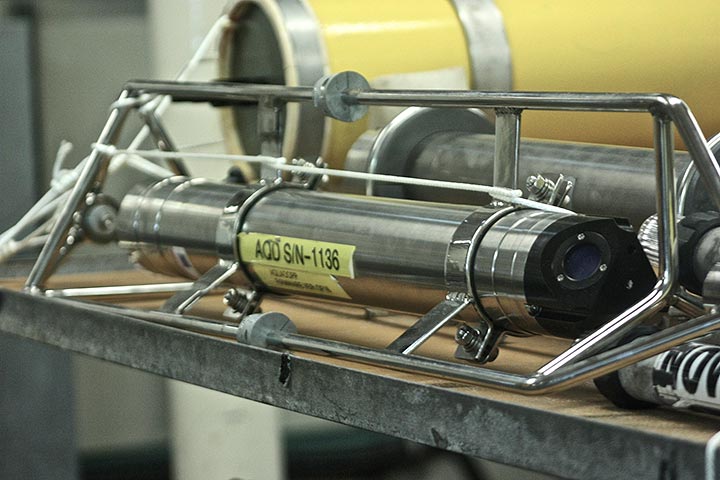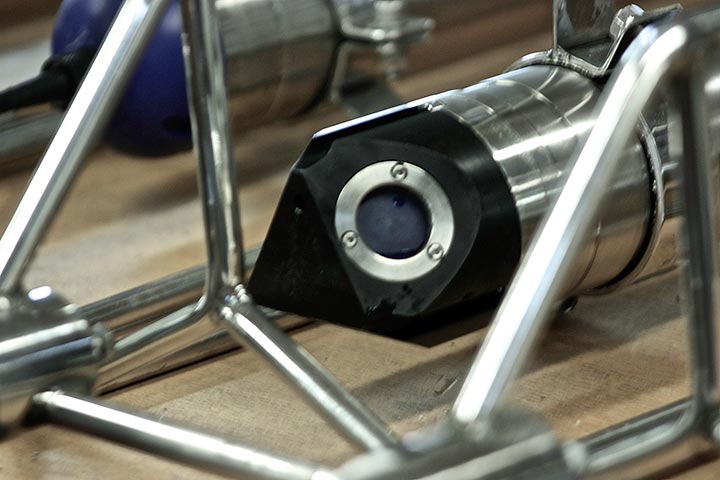
Well, we don’t want to get too giddy, but it looks like our luck’s taking a turn for the better. The sharp techs from Melville and the University of Miami pulled three moorings in the last two days without a hitch, despite 15-foot swells. (By the way, when wind imparts its energy directly to the surface, waves result; when the wind dies, residual energy remains for a time in the form of swells.) Now, under clear skies, light winds, even the swells have diminished, but I’ve never seen the Agulhas lie flat. There’s just too much motion in the water and the air. But the latest meteorological map shows a large zone of high pressure pressing in from the west, so our weather luck should hold for a few days.
Lisa wants to measure the total volume of water transported by the Agulhas Current (remember the measurement unit called Sverdrups?), and the way to learn total volume is to measure velocity. There are two ways to do that. You can release devices to float independently with the current, which then report their position, usually via satellite, back to the ship or to a shoreside station; this is the so-called Lagrangian method. Conversely, by the Eulerian method, the one we’re using, you fix the measuring device in place—on a mooring wire—and let the current flow past it.
There are two basic types of Eulerian velocity-measuring instruments, the current meter and the Acoustic Doppler Current Profiler (ADCP). Both shoot acoustic pulses—pings like in the old submarine movies—at a particular frequency out into the water. Encountering particles such as plankton or bits of sediment carried with the current, the pings bounce back at a slightly different frequency. You may have noticed how the audible pitch of a fire-engine siren changes as it approaches and passes. This is the so-called “Doppler shift.” By measuring the shift between the out-going and return frequencies, you can indirectly glean the speed of the current from the speed of the particles carried by it. (Most of this sonic gear, originally developed by the navy for submarine warfare, was adapted by oceanographers for peaceable purposes after the Cold War.

Lisa is using both current meters and ADCPs on her moorings. Current meters are attached directly to the wire at various depths, while “upward-looking” ADCPs are mounted on the moorings’ top floats anchored 300 meters beneath the surface to protect them from passing ships and fishing vessels. Down-looking ADCPs are mounted inMelville’s hull pinging the water 24 hours a day, and by factoring out her course and speed, you’re left with current velocity… But wait, you may be asking, if the top floats are anchored 300 meters down, how do we retrieve the moorings? Yeah, that’s a good question; it totally befuddled me on my first cruise some years ago. Clever oceanographers developed another sonic device—the acoustic release—to solve that obvious retrieval problem. We’ll get to that when it comes up again, no pun intended. Really.
What Shakespeare called the “vasty deep” never relaxes even when the surface appears dead flat. Movement is constant, but not necessarily consistent, at all depths and all timescales. And for the oceanographer this meansvariation. You can’t measure the velocity of a current only once and assume you’ve nailed it. Next week it could be faster. Or slower. To understand the mean flow, you have to resolve the variations, and only repeated measurements will do that. That’s why these instruments need to remain in the water for over a year—and why Lisa called her project the Agulhas Current Time-Series.











